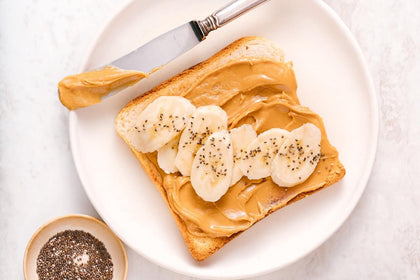You are what you eat. And food, particularly protein, fuels the body. Yet, those on a vegan diet may find it challenging to get enough protein. The good news is that plenty of plant-based protein options exist, making it possible to fuel up properly without compromising your lifestyle.
As wellness begins from within, it's essential to watch what you’re putting into — and on — your body. That's why it's equally important to keep your beauty and hair care routine as clean and vegan as your diet. Read on to learn more about vegan protein sources — plus, find out what products you should be using for head-to-toe wellness.
#include-related-slider#
How Protein Powers the Body
Protein, made from nine essential amino acids, is essential for many of the body's functions, such as carrying oxygen throughout the blood. Protein is a necessary building block for muscle mass and is used to build and repair tissue, muscles, cartilage, bones and skin. Protein is also a necessity for a healthy scalp and hair growth.
Protein's health benefits are important for everyone, potentially more so on vegan diets, which often require thinking outside the box to get enough protein. However, protein sources powered by plants are more abundant than you may think. And, you don't necessarily need to make a special trip to health food stores to find meat substitutes or other vegan sources of protein. Think nuts and seeds, whole grains, legumes, certain fruits and vegetables, soy products and other pantry staples as some of the best vegan protein sources.
Shop: Vegan Supplements
How Much Protein Do You Need Each Day?
Although protein is an essential macronutrient, not all food sources of protein are equal. Additionally, the amount of protein you should consume each day is unique and will vary per person.
According to the National Library of Medicine, the daily recommended intake of protein for healthy adults is 10%-35% of total calorie needs, and 1 gram of protein supplies four calories. So, if you follow an 1,800 calorie diet and eat 90 grams of protein per day, that equals 360 calories or 20% of your total calorie needs. The amount of protein you need can fluctuate, however, and will increase if you lead an active lifestyle that requires more protein to support physical processes.
Read: 9 Vegan Foods With Biotin
A Dozen Plant-Based Protein Powerhouses
While it can be challenging to find protein sources as a vegan, there are plenty of options. Here's what to eat to power up with plant-based proteins.
1. Tofu
When thinking of vegan protein sources, tofu likely immediately comes to mind. Made of soybeans, water and calcium sulfate, it's a naturally occurring mineral that accounts for calcium in food. Plus, it's very versatile and can be integrated into just about any recipe. Not all tofu has the same protein content, however, so compare labels to find brands with the highest amount of protein per serving. According to the U.S. Department of Agriculture, a 1/2 cup serving of tofu has 21.8 grams of protein.
Play with the texture, shape and size of tofu. Try cutting it into small cubes or crumbles, reducing moisture content for a "meaty, hearty texture" that can be used as a pizza topping or taco or sandwich fillings. You can also mix tofu into a salad or add it to stir-fried quinoa bowls or noodle dishes.
2. Tempeh
Fermentation sets tempeh apart from soy foods like tofu and soy milk, giving it a more dense, cake-like consistency. Tempeh has a strong, nutty flavor and is versatile, absorbing the flavors of any dish.
With its dense texture, tempeh is a great meat substitute for chilis, stews, sandwiches, tacos or even served as a vegan "steak." Plus, the fermentation process adds to its nutritional value, packing tempeh with both protein and probiotics. According to the USDA, a 1 cup serving of tempeh has 33.7 grams of protein.
Read: 4 Nutrition Choices Affecting Your Hair
3. Nuts and Seeds
Pumpkin seeds, flax seeds, chia seeds, hemp seeds, sunflower seeds, peanuts, almonds, pistachios, walnuts and cashews are good sources of protein for plant-based diets. Pistachios, according to the Food and Drug Administration, meet the definition of a complete protein, a food that contains “all of the essential amino acids in adequate amounts" such as soybeans, chickpeas and quinoa. Raw pistachios pack 24.8 grams of protein in 1 cup.
Nuts and seeds are shelf-stable, easy to take on the go or to be used as an ingredient in more substantial meals. Sprinkle them on salads and bowls for both texture and a protein boost. Make a healthy homemade trail mix, muffins, pancakes and other baked goods.
You can also whip up a custom vegan nut cheese. Begin by soaking the nuts in water for a minimum of four hours to soften. Combine with nutritional yeast (for cheese flavor), apple cider vinegar and lemon. Salt to taste and add any other preferred spices. Blend all ingredients in a food processor until desired consistency is reached.
Shop: Anna Grace Newell's Favorite VEGAMOUR Picks
4. Nut Butter
Peanut butter and almond butter typically contain 3 to 4 grams of protein per tbsp, serving. For those with nut allergies, there's also sunflower butter, but the protein content is typically a bit lower.
Use nut or seed butter in sandwiches or as a protein-rich ingredient in baked goods and protein balls.
5. Nutritional Yeast
Nutritional yeast has a cheese-like flavor. As the name suggests, nutritional yeast is teeming with nutrients and includes around 8 grams of protein per serving and a healthy dose of vitamin B-12.
Sprinkle it on popcorn, baked potatoes or veggies. You can add it to just about anything, including sauces, scrambles, bowls and salads. Or you can mix it into dough for biscuits and crackers.
6. Ancient Grains
Ancient grains are generally thought to be those that have been unchanged over the years. One cup of cooked amaranth has 9.35 grams of protein. Other cooked grains such as farro, spelt, barley, black rice, quinoa and buckwheat range from 4-11 grams of protein per cup.
Try using ancient grains in recipes as the base for bowls, side dishes and salad toppings. Or swap out oatmeal for breakfast porridge.
Also: 5 Nutrients Your Hair Craves
7. Green Peas
Like lentils and chickpeas, green peas are legumes. One cup usually contains around 8 grams of protein, along with other key nutrients such as fiber, folate, copper, niacin, phosphorus and vitamins A, C, E and B-6.
Green pea protein is a great option for people with food sensitivities to soy or whey. Try pea protein meat substitutes or snacks, or opt for whole, unprocessed green peas in soups, salads, bowls, pastas and stir-fry dishes.
8. Garbanzo Beans
Also known as chickpeas, garbanzo beans have 8 grams of protein per 1/2 cup and are fiber- and iron-rich. Plus, they have the potential to positively impact gut health and lower the risks of serious ailments such as heart disease and diabetes.
Pair with grains bowls or salad as a source of protein. They're the foundation of hummus dips, falafel patties or chickpea flour. Tip: Deskin the beans before using them for easier digestion and to provide a smoother texture in recipes such as hummus.
9. Lentils
Cooked lentils are easier to digest, offering plenty of protein, coming in second to soybeans. When combined with whole grains, lentils may provide a similar quality of protein as meat, with around 18 grams of protein per serving.
Use lentils as a meat substitute in dishes like tacos, Bolognese or other traditional meat recipes.
10. Whole Grains
Brown and wild rice pack more of a protein punch than other grains. Wild rice is also considered a complete protein, containing fewer calories and more protein than brown (or other) rice varieties, with 6.5 grams of plant protein per cup. Brown rice, however, has more B vitamins and 4.5 grams of protein per cup. Both may help reduce blood pressure and contain fiber, antioxidants, manganese, magnesium and phosphorus.
Use brown or wild rice as the base in bowls, as side dishes or as an addition to salads.
11. Avocados
Avocados are higher in protein than other fruits, with about 5 per cup or 7 grams per whole fruit. Avocados are also rife with Omega-3 fatty acids, the "healthy" type of fat, plus magnesium, phosphorus, iron, pantothenic acid (vitamin B-5), vitamin K and fiber, which aids digestion and helps maintain regularity and contain even more potassium per gram than bananas.
Use these green fruits to make avocado toast, dips, guacamole, tacos or to top a salad.
12. Protein Powder
Protein powders can be mixed into food or drinks. Mix up a smoothie in the morning and take a daily dose of vitamins with it. GRO Biotin Gummies include your daily value of biotin, along with folic acid, Vitamins A, B-5, -6 and -12, C and E and zinc to neutralize free radicals, supporting and nourishing the scalp.
#include-related-slider#
Support Hair and Whole Body Wellness
Treat your whole body, from the inside out, with clean, plant-powered ingredients. Minimize stress and practice mindful self-care in your daily routines to watch the transformation in both internal and external wellness!
More from VEGAMOUR
- These 8 Food and Eating Habits May Contribute to Hair Loss
- Best Foods for Healthy Hair Growth
- How to Boost Your Immune System
Photo credit: ANTONI SHKRABA/Pexels
Back


















